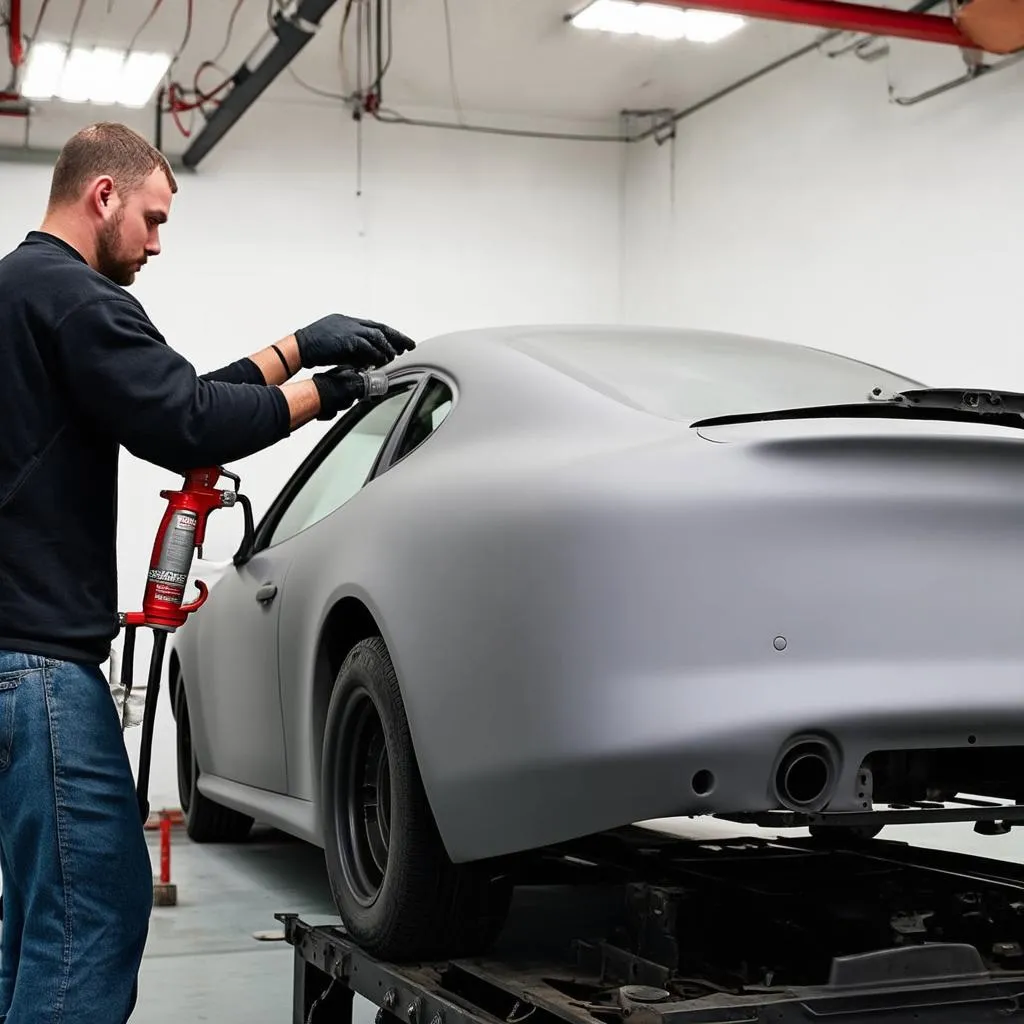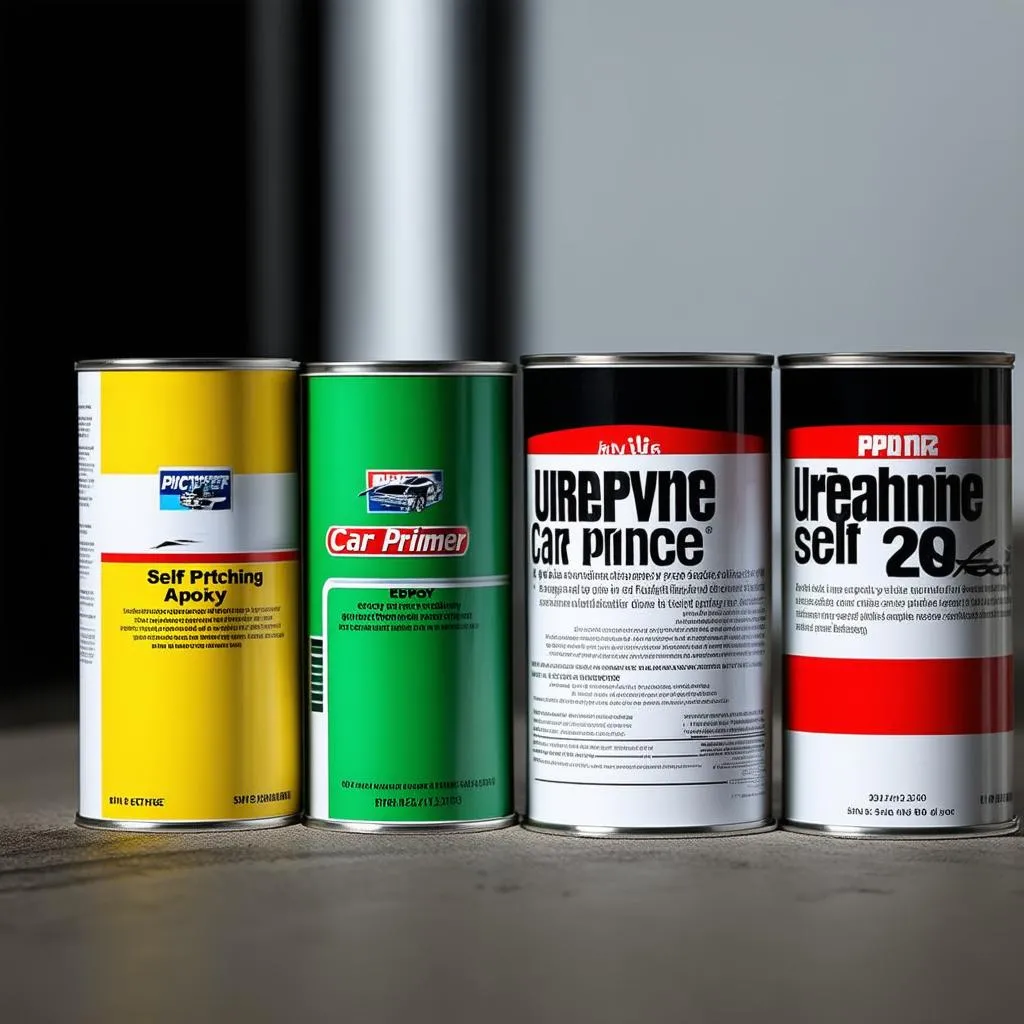Have you ever driven past a car with a paint job so bad it made you cringe? Maybe it was peeling, faded, or just plain rough. A major culprit behind such automotive atrocities is often neglecting a crucial step: the primer.
Think of primer as the unsung hero of the painting process, the foundation upon which a beautiful, lasting finish is built. Here at Tech Car USA, we understand the importance of a quality paint job. That’s why we’re diving deep into the world of car paint primer, exploring its nuances and answering all your burning questions.
What is Paint Primer For Cars, Anyway?
Imagine you’re building a house. You wouldn’t slap expensive wallpaper directly onto bare bricks, would you? Primer is like the plaster and drywall, creating a smooth, uniform surface for the paint to adhere to.
From a mechanic’s perspective, John Miller, a seasoned mechanic at a Ford dealership in Chicago, puts it best: “Primer acts as a mediator between the bare metal of your car and the topcoat. Without it, you’re essentially asking for trouble.”
Technically speaking, primer is a specialized paint formulated to bond with bare metal, fiberglass, or existing paint, providing a stable base for the color coat. It fills in imperfections, prevents rust, and ensures an even, professional-looking finish.
Economically, using primer can save you money in the long run. A properly primed surface requires fewer coats of expensive paint and resists fading and peeling, extending the life of your paint job.
Why Should You Use Primer on Your Car?
Let’s say you’re restoring a classic 1967 Mustang. You’ve sourced original parts from a salvage yard in Arizona, painstakingly sanded down the bodywork, and are ready for paint. Skipping the primer would be like wearing flip-flops to a black-tie event – a major faux pas.
Here’s why primer is non-negotiable:
- Adhesion: Primer forms a strong bond with both the car’s surface and the topcoat, ensuring the paint doesn’t chip, peel, or flake off.
- Corrosion Protection: Ever seen a car with rust bubbling up under the paint? Primer acts as a barrier against moisture and air, preventing rust and corrosion.
- Uniform Finish: Primer fills in minor scratches, dents, and imperfections, creating a smooth, consistent surface for an even paint application.
Types of Primer and When to Use Them
Just like there are different types of cars for different needs (a rugged Jeep for off-roading, a sleek Tesla for city driving), there are various primers formulated for specific purposes:
1. Epoxy Primer:
This heavy-duty primer is your go-to for bare metal. It offers superior adhesion and corrosion resistance, making it ideal for collision repairs or full restorations.
2. Urethane Primer:
This versatile primer is compatible with most surfaces, including metal, fiberglass, and even some plastics. It fills in minor imperfections and provides a smooth base for paint.
3. Self-Etching Primer:
This specialized primer chemically etches into the metal, creating an incredibly strong bond. It’s often used on aluminum and other non-ferrous metals.
4. Acrylic Primer/Filler:
Need to fill in deeper scratches or imperfections? This primer is thicker and sandable, allowing you to create a perfectly smooth surface before applying the topcoat.
Common Questions About Car Paint Primer:
1. Can I Use Any Primer on My Car?
While you might be tempted to grab that leftover can of latex primer from your last home improvement project, resist the urge! Car paint primers are specially formulated to withstand the harsh conditions automobiles face: UV rays, temperature fluctuations, and the occasional errant shopping cart.
2. Do I Need to Sand the Primer Before Painting?
In most cases, yes. Sanding the primer creates a slightly rough surface, which helps the paint adhere better. However, some newer primers are designed to be “non-sanding,” so always check the manufacturer’s instructions.
3. How Many Coats of Primer Do I Need?
Generally, two to three thin coats of primer are sufficient. Remember, multiple thin coats are always better than one thick, gloppy coat. Allow each coat to dry completely before applying the next.
Beyond Primer: Tips for a Flawless Finish
- Preparation is Key: Thoroughly clean and sand the surface before applying primer. Any dirt, grease, or rust will compromise the adhesion of both the primer and paint.
- Use the Right Tools: Invest in quality paintbrushes, rollers, or a spray gun designed for automotive use. The right tools make all the difference in achieving a professional-looking finish.
- Patience is a Virtue: Allow ample drying time between each coat of primer and paint. Rushing the process can lead to imperfections and a less durable finish.
 Applying car primer
Applying car primer
Similar Questions About Car Paint and Bodywork:
- What is the best type of paint for cars?
- How to repair minor scratches on my car?
- Can I paint my car myself at home?
- What are the different types of clear coats for cars?
- How to protect my car’s paint from fading?
 Different types of car primer
Different types of car primer
Need Help with Your Car’s Paint?
At Tech Car USA, we’re passionate about helping car enthusiasts achieve the perfect paint job. Whether you’re a seasoned DIYer or prefer to leave it to the professionals, we’re here to answer your questions and provide expert advice.
Need personalized assistance with your car’s paint or need help finding the right tools and products? Contact us on Whatsapp at +84767531508. Our team of automotive experts is available 24/7 to assist you.
Conclusion
Just like a strong foundation is essential for a sturdy building, using the right paint primer is crucial for a beautiful, long-lasting car paint job. By understanding the different types of primer, their applications, and following the proper techniques, you can achieve a professional-looking finish that will turn heads for years to come.
We encourage you to share your own car painting experiences, tips, and questions in the comments below. And don’t forget to explore our other informative articles on car maintenance, repairs, and modifications here at Tech Car USA.